Related Research Articles
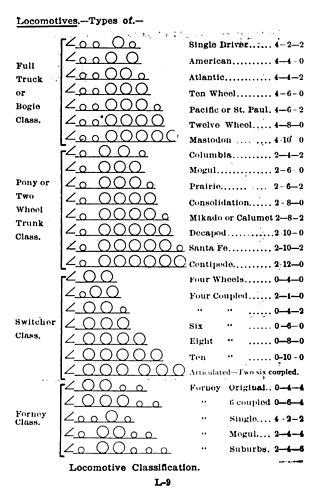
Whyte notation is a classification method for steam locomotives, and some internal combustion locomotives and electric locomotives, by wheel arrangement. It was devised by Frederick Methvan Whyte, and came into use in the early twentieth century following a December 1900 editorial in American Engineer and Railroad Journal.
In rail transport, a wheel arrangement or wheel configuration is a system of classifying the way in which wheels are distributed under a locomotive. Several notations exist to describe the wheel assemblies of a locomotive by type, position, and connections, with the adopted notations varying by country. Within a given country, different notations may also be employed for different kinds of locomotives, such as steam, electric, and diesel powered.

In the Whyte notation for classifying the wheel arrangement of steam locomotives, an 0-8-8-0 is a locomotive with two sets of eight driving wheels and neither leading wheels nor trailing wheels. Two sets of driving wheels would give far too long a wheelbase to be mounted in a fixed locomotive frame, so all 0-8-8-0s have been articulated locomotives of the Mallet type, whether simple or compound. In the UIC classification, this arrangement would be, refined to Mallet locomotives, (D)D. The type was sometimes called Angus in North America.
Under the Whyte notation for the classification of steam locomotives, 0-10-2 represents the wheel arrangement of no leading wheels, ten powered and coupled driving wheels on five axles, and two trailing wheels on one axle.
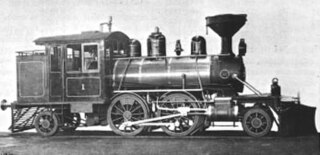
Under the Whyte notation for the classification of steam locomotives, 2-4-2 represents the wheel arrangement of two leading wheels on one axle, four powered and coupled driving wheels on two axles and two trailing wheels on one axle. The type is sometimes named Columbia after a Baldwin 2-4-2 locomotive was showcased at the 1893 World's Columbian Exposition held at Chicago, Illinois.

In Whyte notation, a 2-4-4, or Boston-type, is a steam locomotive with two unpowered leading wheels followed by four powered driving wheels and four unpowered trailing wheels.

Under the Whyte notation for the classification of steam locomotives by wheel arrangement, 6-8-6 represents the arrangement of six unpowered leading wheels arranged into a three-axle leading truck, eight powered driving wheels, and six unpowered trailing wheels arranged into a three-axle trailing truck.
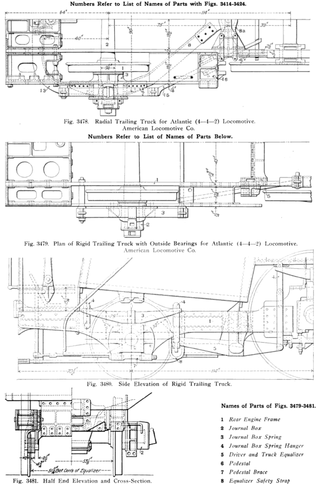
On a steam locomotive, a trailing wheel or trailing axle is generally an unpowered wheel or axle (wheelset) located behind the driving wheels. The axle of the trailing wheels is usually located in a trailing truck. On some large locomotives, a booster engine was mounted on the trailing truck to provide extra tractive effort when starting a heavy train and at low speeds on gradients.
Under the Whyte notation for the classification of steam locomotives, 0-8-2 represents the wheel arrangement of no leading wheels, eight powered and coupled driving wheels on four axles, and two trailing wheels on one axle.

An 0-2-2, in the Whyte notation for the classification of steam locomotives by wheel arrangement, is one that has two coupled driving wheels followed by two trailing wheels, with no leading wheels. The configuration was briefly built by Robert Stephenson and Company for the Liverpool and Manchester Railway
A 4-4-6-4, in the Whyte notation for the classification of steam locomotives by wheel arrangement, is one that has four leading wheels followed by four coupled driving wheels, a second set of six coupled driving wheels and four trailing wheels.

Under the Whyte notation for the classification of steam locomotives, 4-10-0 represents the wheel arrangement of four leading wheels, ten powered and coupled driving wheels, and no trailing wheels. Central Pacific Railroad's El Gobernador, built in 1883, was the only locomotive with this wheel arrangement to operate in the United States. The name "Mastodon" has also been applied to this type, though this nickname has also been mistakenly used for the 4-8-0 arrangement, leading to some confusion. Sources refer to the 4-8-0 as the Twelve-wheeler. Later, these locomotives were named "Super Mastodon's."
In Whyte notation, a 4-6-6-2 is a steam locomotive with four leading wheels in an unpowered bogie at the front of the locomotive followed by two sets of driving wheels with six wheels each, followed by two unpowered trailing wheels at the rear of the locomotive.
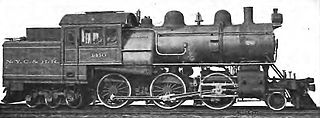
In the Whyte notation for describing steam locomotive wheel arrangement, a 2-6-6 is a locomotive with a two-wheeled leading truck, six driving wheels, and a six-wheeled trailing truck. All the locomotives produced of this arrangement have been tank locomotives, and the vast majority in the United States. It was a popular arrangement for the larger Mason Bogies, as well as some of the largest suburban tank locomotives.
Under the Whyte notation for the classification of steam locomotives by wheel arrangement, the 2-4-2+2-4-2 is a Garratt articulated locomotive. The wheel arrangement is effectively two 2-4-2 locomotives operating back to back, with the boiler and cab suspended between the two power units. Each power unit has a single pair of leading wheels in a leading truck, followed by two coupled pairs of driving wheels, with a single pair of trailing wheels in a trailing truck. Since the 2-4-2 type is sometimes known as a Columbia, the corresponding Garratt type could be referred to as a Double Columbia.
An 0-4-6T, in the Whyte notation for the classification of steam locomotives by wheel arrangement, is a locomotive with no leading wheels, four driving wheels fixed in a rigid frame, and six trailing wheels. Examples of this type of locomotive were built by Wilhelm von Engerth.

A 4-4-6, in the Whyte notation for the classification of steam locomotives by wheel arrangement, is a locomotive with:
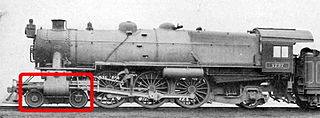
The leading wheel or leading axle or pilot wheel of a steam locomotive is an unpowered wheel or axle located in front of the driving wheels. The axle or axles of the leading wheels are normally located on a leading truck. Leading wheels are used to help the locomotive negotiate curves and to support the front portion of the boiler.
A 2-4-6-2 steam locomotive, in the Whyte notation for describing locomotive wheel arrangements, has a two-wheel leading truck, one set of four driving wheels, one set of six driving wheels, and a two-wheel trailing truck.
Under the Whyte notation for the classification of steam locomotive wheel arrangements, a 4-4-6-2 is a locomotive with two pairs of leading wheels, one set of four driving wheels, a second set of six driving wheels, and a pair of trailing wheels.
References
- ↑ "Wheel Arrangements". Railway Technical Web Pages. 1 August 2011. Archived from the original on 2016-03-04. Retrieved 1 August 2011.